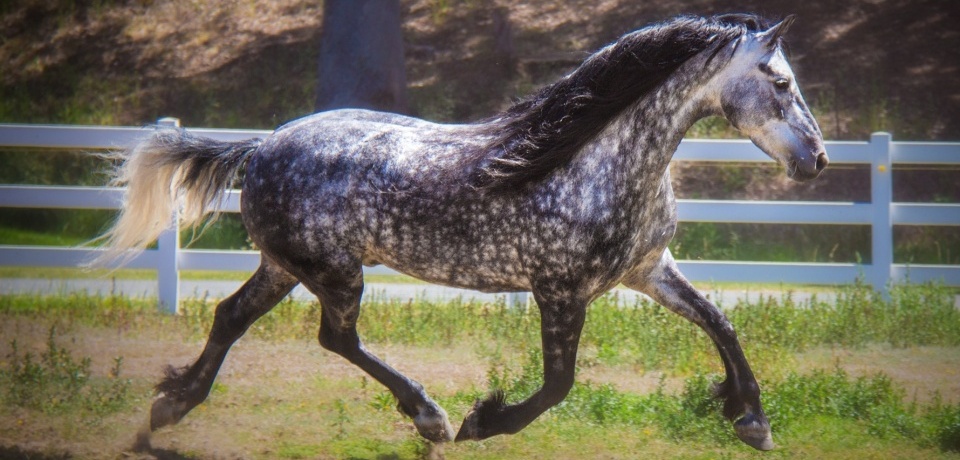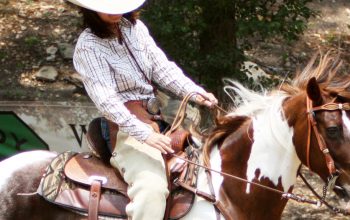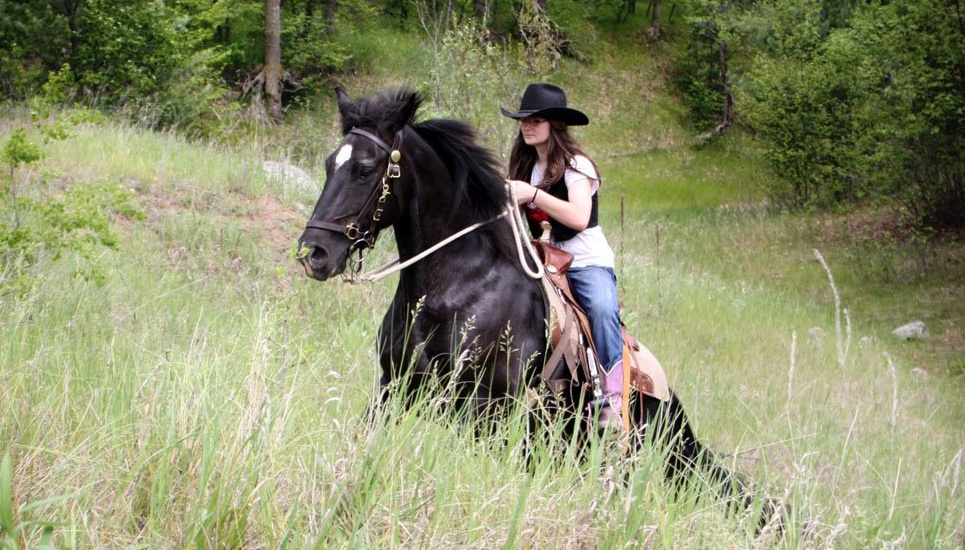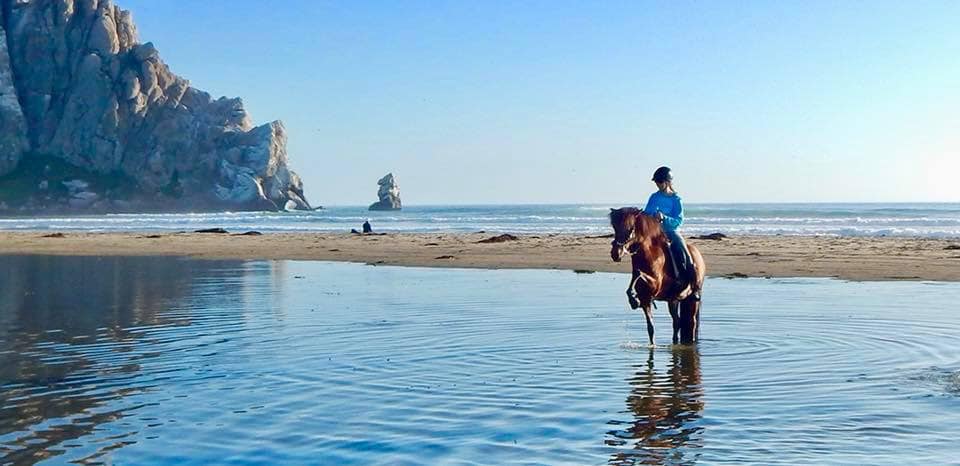
By Karen-Maree’ Kaye
Koala Bears and Kangaroo’s first spring to mind when you think of animals that come from Australia – certainly not a breed of horse called a Warlander. However, 27 years ago from the ‘land down under’ is exactly where the Warlander horse began its journey and nowhere more so than North America, has it gained popularity, amongst pleasure riders and professionals alike.

Primarily, the Warlander is a baroque horse derived from the crossing of registered purebred Friesian and Iberian horse breeds. More specifically, to be registered ‘Warlander’ a horse must fit the requirements of a regulated breed standard set by the mother studbook for the breed – Warlander Studbook Society.
We talk to founder of the Warlander horse, Karen-Maree’ Kaye of the Classical Sporthorse Stud in Western Australia. In 1990, Karen-Maree’ began a dedicated breeding program, penned the first breed standard and named the breed after veterinarian Warwick Vale.
“The crossing of purebred Friesian and Iberian horse is not new. It is probable that during the crusades and later the ‘Eighty Year War’ that Iberian horses were bred to native breeds of the Netherlands including the Friesian,” she tells us.
“I bred the Warlander for a future haute école (advanced classical dressage) horse for myself. But after the first one, I was amazed by how this hybrid developed and how complementary both base breeds were to each other, with the resultant progeny gaining the best attributes of both.”
The first Warlander she bred was, she says, “Extremely functional, collected very easily, was really comfortable to ride and had inherited the Friesian’s placid nature with the sensibility and bravery of the Iberian.”
They say the rest is history. The Warlander horse, over a relatively short period of time was embraced globally and can be found throughout Europe, North and South America, Australia… even South Africa and Israel.

“Europe and North America though, is where we are seeing the Warlander flourish. To gain breed status, it first had to be recognized in Europe and in 2010 Warlander horses received full paper work according to European standards where they are now judged by the European classification system up to breeding approval including performance testing,” says Karen-Maree’. However, America has played a big part in the Warlander horses history with the formation of the original mother studbook and USA breeders have taken the Warlander into the third generation,” she continues. “Importantly, we have five quality Warlander breeding stallions in the USA (as of the original printing of this story in 2017), and ‘now’ is the most exciting time for the Warlander horse in our country,” says Lisa Oberman who heads the ‘newly’ formed Warlander USA.
“As the mother studbook now resides in Australia, it was important for North America to have our own organization. We are embarking on a journey to start up a national show circuit for the Warlander horse and more importantly, ensure the standards of the breed remain consistent in our country,” says Lisa.
“The essence of a Warlander horse is their sweet, friendly and willing nature. The majority of Warlander owners have them because they want to ‘connect’ and have a lifelong friend and partner. A ‘best friend’ that is versatile, – and that is exactly what the Warlander offers,” says Lisa.

“When it comes to versatility there are no hard set of rules for the Warlander. “Throw anything at them – dressage, western driving, haute ecole, jousting, trail riding, commercial work or pleasure pursuits and the Warlander will try their hearts for you.
“We have seen so many beautiful relationships develop over the years between owners and their Warlander horses – showing foremost they are a cherished family horse,” says Lisa.
These Warlander ‘love affairs’ are not limited to the ladies either. A long time supporter of the breed Chuck Davenport from Immortal Farms in Marysville, Washington says,” Warlander horses do indeed make terrific mounts for any aspiring knight.” Chuck would certainly know as he cuts a dashing figure aboard his charger I.F Aragorn (aka Strider) at a local Renaissance Fairs.
Cheryl Painter is incredibly proud of her Warlander gelding Abacus Xanthus and rightfully so. Xanny, as he is known, successfully competes in Combined Driving Events, Dressage and Carriage Shows and has a national title in driving, won at the Andalusian Show at Lexington, Virginia. “He is happy doing whatever is asked as long as he is with his ‘people,” says Cheryl.


Award-winning classical trainer Marnie Hoffman says, “The Warlander has a natural charm and their mind is priceless.” Marnie is the trainer behind the beautiful Warlander stallion – Hummer who was bred Ramiro Mejia of Vaquero Ranch in California. “There is a bright future for the Warlander. They embody what Friesian and Andalusian lovers want in a horse, and more and more people are learning about the Warlander, and seeking them out.”
Kathi Stewart of Redwood Valley, California and her Warlander gelding ‘Spyder’ known formally as ‘The Spanish Knight HTR (aka Spyder) speak so loudly of the special relationships that can be built between owners and their Warlander horses. Their love rivals that of husband Randy, who thankfully cherishes Spyder as much as Kathi does.
As well as being a bit of a natural for advanced classical dressage, Spyder is a ‘model’ for the Warlander horse in national, international books and publications and Wikipedia.

Bred by Norma Harris of Harris Trust Ranch, Kathi purchased Spyder from Norma when he was still a baby, at only a year and half of age. “I had the choice of two of Norma’s colts at the time – Spyder or a purebred Andalusian. For me, it was an easy choice. I chose the one with the prettier movement, confirmation and mischievous personality which was Spyder. He won my heart immediately,” says Kathi. “At that time, I did not know about the Warlander breed, but as a blend of my two favorite breeds – what was there not to love? Spyder is my dream horse,” Kathi tells us.
 Now nine years old, Spyder, has been classically trained by Dianne Olds Rossi of Magical World of Dancing Horses and Kathi and has been in several exhibition shows, including performing at the California State Fair.
Now nine years old, Spyder, has been classically trained by Dianne Olds Rossi of Magical World of Dancing Horses and Kathi and has been in several exhibition shows, including performing at the California State Fair.
“Gosh, what do I love about him… everything,” says Kathi.
“He is beautiful, balanced, athletic, sweet, highly intelligent, smooth gaited and still mischievous. Everyone who rides him falls in love with him. I highly recommend the Warlander horse to anyone looking for a nice combination of beauty and athleticism. When bred well, you truly get the perfect blend of both breeds – agility, nice bone structure, strong neck, shorter back, beautiful gaits, lots of hair and if you are really lucky, feathers,” finishes Kathi.
What is a Warlander?
A powerful, baroque horse carrying no outside blood other than pure registered Friesian and Iberian horse breeds in a ratio of no less or more than 25 / 75% ratio.
The Warlander horse is unique in that it is racially correct in the first generation (F1 -50/50%). This can only be replicated again when two 50/50% or two 25/75% Warlander horses, each carrying a higher percentage of Friesian or Iberian, are bred together.
The head is noble and expressive with a straight or slightly convex profile and intelligent eyes. The neck is wide, well-muscled and well set with a good throatlatch. The mane is lush with dense, but not coarse hair. The shoulder is strong, long and sloping and the withers well marked. The back is strong and well-muscled and the croup is well muscled and not too short. The legs are strong with a matching length, well developed, large and dry joints, well-muscled upper and lower arms and big hooves. All base colors occur in the breed. Pintos and Appaloosa markings are not allowed. White head and leg markings are permitted. The shoulder height is 150 to 165 cm (14.3-16.1 hands).
*This story was originally published in the February 2017 issue of Sport and Trail Magazine.
Warlander Studbook Society: www.facebook.com/groups/warlanderstudbooksociety/
Warlander USA: www.facebook.com/groups/1126000530847639/
For more information visit www.warlanderstudbooksociety.com.au




